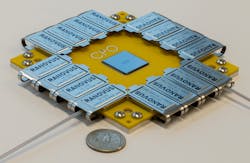Ranovus announces single chip Odin silicon photonic engines for pluggable optical transceivers, co-packaged optics
Ranovus Inc. has leveraged its multi-wavelength quantum dot laser (QDL) and micro ring resonator technology to create the Odin line of silicon photonics engines. The Odin 8 focuses on the optical transceiver space the company has traditionally served (see, for example, “Ranovus unveils optical engine, 200-Gbps PAM4 optical transceiver”), while the Odin 32 will target co-packaged optics applications.
The Odin engines comprise a 1550-nm QDL, 100-Gbps silicon photonics-based micro ring resonator modulators and photodetectors, a 100-Gbps driver, 100-Gbps transimpedance amplifier (TIA), and control ICs. The Odin device enables a 50% power consumption/Gbps reduction and 75% cost/Gbps reduction versus current alternatives, asserts Hamid Arabzadeh, chairman and CEO at Ranovus.
The Odin 8 will be the first device to market. It will target 8x100G optical transceiver applications while offering support for 64/50-Gbps PAM4 and 50/32/25-Gbps NRZ applications. The company has two PAM4 IC partners to support transceiver design and three lead customers in place, Arabzadeh revealed. The protocol-agnostic Odin 8 will offer 0.4-nsec latency and transmission reaches of 2 to 10 km. Arabzadeh and Ranovus expect the Odin 8 to be at the heart of QSFP-DD800 and OSFP modules in DR and FR configurations. Engineering samples of the Odin 8 should be available by the first quarter of 2021, Arabzadeh predicted.
Ranovus will earmark the Odin 32, which will be taped out at the same time as the Odin 8, for co-packaged optics applications. The photonic engine targets co-packaged 51.2-Tbps switch applications. The engine will support eight 4x100G fibers for a total of 3.2 Tbps. The company is creating an ecosystem for the Odin 32, which Arabzadeh expects will enable the device to be used in open design environments.
For related articles, visit the Optical Technologies Topic Center.
For more information on optical components and suppliers, visit the Lightwave Buyer’s Guide.
To stay abreast of optical communications technology, subscribe to Lightwave’s Enabling Technologies Newsletter.
About the Author

Stephen Hardy
Editorial Director and Associate Publisher, Lightwave
Stephen Hardy is editorial director and associate publisher of Lightwave and Broadband Technology Report, part of the Lighting & Technology Group at Endeavor Business Media. Stephen is responsible for establishing and executing editorial strategy across the both brands’ websites, email newsletters, events, and other information products. He has covered the fiber-optics space for more than 20 years, and communications and technology for more than 35 years. During his tenure, Lightwave has received awards from Folio: and the American Society of Business Press Editors (ASBPE) for editorial excellence. Prior to joining Lightwave in 1997, Stephen worked for Telecommunications magazine and the Journal of Electronic Defense.
Stephen has moderated panels at numerous events, including the Optica Executive Forum, ECOC, and SCTE Cable-Tec Expo. He also is program director for the Lightwave Innovation Reviews and the Diamond Technology Reviews.
He has written numerous articles in all aspects of optical communications and fiber-optic networks, including fiber to the home (FTTH), PON, optical components, DWDM, fiber cables, packet optical transport, optical transceivers, lasers, fiber optic testing, and more.
You can connect with Stephen on LinkedIn as well as Twitter.
